Theatrical
Advertising
Images
CLICK TO
ENLARGE
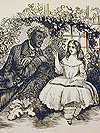
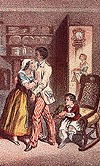
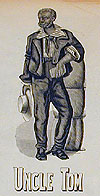
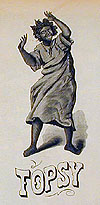
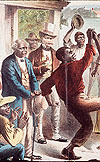
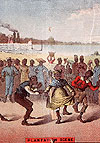
As these scenes became larger parts of the play, the way "Uncle Tom's Cabin" depicted "slavery" was dramatically redefined. You could call the "Tom Show" the triumph of minstrelsy over Stowe's abolitionist protest, or even the American equivalent to "Springtime for Hitler," the upbeat musical about Nazi Germany that is featured in Mel Brooks' Producers. Given the extraordinary popularity of these productions with American audiences for well over three decades, it's important to explore as fully as possible the process by which these entertainments were interpolated into Stowe and Aiken's "moral melodrama."
One of the promptbooks in the Howard Family Colllection at the University of Texas' Harry Ransom Humanities Research Center preserves what looks like an early stage in that process. Like many UTC Companies' promptbooks, it combines printed sections from Samuel French's 1858 publication of Aiken's text with handwritten sections where new material was added to the script. The promptbook is undated, but includes in the back pages AN ACT-BY-ACT SYNOPSIS OF THE PLAY from The (New York) Stage, 7 September 1869, that is essentially the same as this script. (Pasted inside the promptbook's front cover are SECTIONS FROM AN UNDATED PLAYBILL with a similar synopsis, but dividing the play into 4 acts instead of 6, and eliminating, for example, the scenes of Ophelia and Topsy in Vermont; these changes make it clear that even within one company like the Howards', the play was often undergoing revision, so no one script or promptbook can represent the "performance text" of Uncle Tom's Cabin at more than one given point in time.)
The excerpts from this script (below) reveal several conspicuous departures from Aiken. Legree is brought into the story and onto the stage almost from the start, and is involved in the (fraudulent) sale of Tom to St. Clare. Act 4, Scene 1 begins with a page pasted in from Aiken's 1858 text, the conversation between Tom and St. Clare about the evils of drinking -- but in Aiken's original play, that occurs in Act 3, Scene 1; by moving it later, this version uses it to help suggest St. Clare's collapse under the weight of his grief over Eva's death. This version adds a scene (4, 3) in the barroom where he is mortally wounded, only now it is Legree who kills him (in part to cover up the earlier fraud).
In the history of the novel on stage, these kinds of revisions were constantly going on, and often reflect simply the strengths or limitations of a particular company. Along these lines, note the way this particular promptbook crosses out "Marks" and replaces that name with "Haley." Since Marks was one of the audiences' favorite characters ("Double Tom Shows" featured two Markses as well as two Topsys), one might have expected the production to use the actor playing someone like Shelby in Act 1 to double up as Marks later, but perhaps at this time the troupe lacked an actor who could do the kind of comedy that audiences expected from Marks's character. This script also introduces a character I haven't seen in any other source, a crony of Legree's named "Fitz Hugh Coffin."
In terms of the development of the Tom Show, the most significant revision occurs right at the beginning. Aiken's original text starts with George Harris protesting his lot as a slave, but this production begins with a group of "planation hands" paying tribute to their "Massa Shelby," and then singing and dancing through what the synopses call "A Winter Night's Rejoicing of the Slaves." Here the "rejoicing" lasts until whenever (as the promptbook puts it) "it is desirable to end the plantation frolic." In historical terms, this kind of "frolic"ing didn't end until the Great Depression of the 1930s, when the Tom Shows finally came off the road.
Other playbills from around 1870 indicate that it quickly became common to start the play with a musical number by the company's African American performers, though the scene was more typically referred to as "A Winter Night's Lament of the Slaves," and probably featured soulful spirituals rather than the uptempo minstrel tunes that are suggested by the word "frolic." More often, the "plantation scenes" occured later in the play -- even at the auction scene and at Legree's plantation (when Simon himself is not around, that is). This 1869 promptbook probably called for another musical number, at the point referred to in the 4-act synopsis as "Negro Chorus and Breakdown" in a "SWAMP in the VICINITY OF LEGREE'S PLANTATION. In the book there are pasted Aiken pages over a hand-written scene at this point; the original scene is almost entirely illegible, but the few letters that can be read indicate another "frolic."
You can see a complete Howard promptbook from a few years later HERE. It shows in detail how "slaves" singing and dancing were incorporated into the play.
The George C. Howard and Family Collection
Harry Ransom Humanities Research Center
at the University of Texas at Austin
